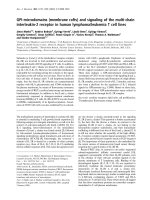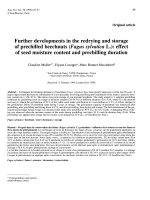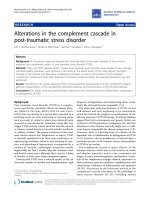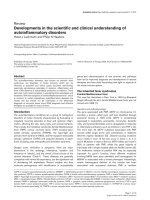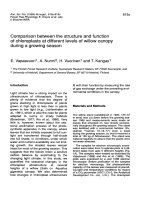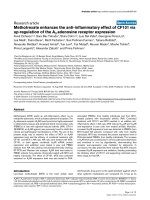Báo cáo y học: "Corticosteroids influence the mortality and morbidity of acute critical illnes" pot
Bạn đang xem bản rút gọn của tài liệu. Xem và tải ngay bản đầy đủ của tài liệu tại đây (143.02 KB, 9 trang )
Open Access
Available online />Page 1 of 9
(page number not for citation purposes)
Vol 10 No 4
Research
Corticosteroids influence the mortality and morbidity of acute
critical illness
Mohamed Y Rady
1
, Daniel J Johnson
1,2
, Bhavesh Patel
1
, Joel Larson
1
and Richard Helmers
1
1
Department of Critical Care Medicine, Mayo Clinic College of Medicine, Mayo Clinic Hospital, Mayo Clinic, Phoenix, Arizona, USA
2
Department of Surgery, Mayo Clinic College of Medicine, Mayo Clinic Hospital, Mayo Clinic, Phoenix, Arizona, USA
Corresponding author: Mohamed Y Rady,
Received: 18 Apr 2006 Accepted: 26 Jun 2006 Published: 17 Jul 2006
Critical Care 2006, 10:R101 (doi:10.1186/cc4971)
This article is online at: />© 2006 Rady et al.; licensee BioMed Central Ltd.
This is an open access article distributed under the terms of the Creative Commons Attribution License ( />),
which permits unrestricted use, distribution, and reproduction in any medium, provided the original work is properly cited.
Abstract
Introduction Use of corticosteroids for adrenal
supplementation and attenuation of the inflammatory and
immune response is widespread in acute critical illness. The
study hypothesis was that exposure to corticosteroids
influences the mortality and morbidity in acute critical illness.
Methods This case–control retrospective study was performed
in a single multidisciplinary intensive care unit at a tertiary care
institution and consisted of 10,285 critically ill patients admitted
between 1 January 1999 and 31 December 2004.
Demographics, comorbidities, acute illness characteristics
including severity measured by Sequential Organ Failure
Assessment, concurrent medications, therapeutic interventions
and incidence of infections were obtained from electronic
medical records, were examined with multiple regression
analysis and were adjusted for propensity of corticosteroid
exposure. The primary outcome was hospital death, and the
secondary outcome was transfer to a care facility at hospital
discharge.
Results Corticosteroid exposure in 2,632 (26%) patients was
characterized by younger age, more females, higher Charlson
comorbidity and maximal daily Sequential Organ Failure
Assessment scores compared with control patients.
Corticosteroids potentiated metabolic and neuromuscular
sequels of critical illness with increased requirements for
diuretics, insulin, protracted weaning from mechanical
ventilation, need for tracheostomy and discharge to a care
facility. Early exposure to corticosteroids predisposed to
recurrent and late onset of polymicrobial and fungal hospital-
acquired infections. Corticosteroids increased the risk for death
or disability after adjustments for comorbidities and acute illness
characteristics.
Conclusion Corticosteroids increased the risk for death or
disability in critical illness. Hospital-acquired infections and
metabolic and neuromuscular sequels of critical illness were
exacerbated by corticosteroids. Careful appraisal of the
indications for use of corticosteroids is necessary to balance the
benefits and risks from exposure in acute critical illness.
Introduction
Administration of corticosteroids in a variety of settings in
acute critical illness has become widespread. Corticosteroids
are used therapeutically for relative adrenal insufficiency as
well as for the attenuation of the inflammatory and immune
response in the critically ill [1]. Early use of corticosteroids has
been recommended in sepsis, acute lung injury, acute respira-
tory distress syndrome and refractory vasodilatory shock [2-5].
The Corticosteroid Randomization after Significant Head
Injury study, a large, international, randomized placebo-con-
trolled trial, was terminated after enrolment of 10,000 patients
because of an unexpected rise in the death rate after early
administration of corticosteroids [6]. That study report raised
concerns with regard to the safety of corticosteroids since, up
to that time, they had been liberally administered in a variety of
life-threatening illnesses with the intent to improve survival.
These concerns were substantiated when we observed, in a
previous study, that administration of corticosteroids
increased the mortality in vasopressor-dependent critical ill-
ness [7]. A similar observation of an unexpected increase in
mortality from corticosteroids use was also reported from a
randomized controlled trial of corticosteroids in late acute res-
piratory distress syndrome [8].
The morbidity related to metabolic, immune and musculoskel-
etal side-effects of corticosteroids in noncritical illness has
ICU = intensive care unit.
Critical Care Vol 10 No 4 Rady et al.
Page 2 of 9
(page number not for citation purposes)
been recognized and has created great interest in developing
alternative treatments to avoid these complications. In trans-
plantation practice, the therapeutic use of corticosteroids for
immunosuppression has decreased because of the introduc-
tion of other therapies targeted against specific cytokines
including tumour necrosis factor and interleukins or selective
lymphocytes calcineurin inhibition [9,10]. New immunosup-
pression regimes produced superior allograft survival and yet
had fewer side effects than traditional high-dose corticoster-
oids [11,12]. For autoimmune inflammatory disorders and
rheumatologic diseases, the use of corticosteroids has also
declined because of better treatment options targeting inflam-
matory cytokines known to influence the progression of these
conditions [13-16].
The use of corticosteroids in noncritical illness has gradually
diminished, yet their use in acute critical illness appears to be
expanding in relative adrenal insufficiency, sepsis and sys-
temic inflammatory organ injury. This study was designed to
address the following questions: What are the frequency and
patient characteristics associated with corticosteroid use in
acute critical illness? Does the exposure to corticosteroids
influence death or disability? What were the mechanisms for
the observed effects of corticosteroids in acute critical illness?
This study was a retrospective case–control analysis of all
admissions to an adult intensive care unit (ICU) with exposure
to corticosteroids defining the case group.
Patients and methods
Study population
The study was granted approval and exemption by the Mayo
Foundation Institutional Review Board. The study was per-
formed at Mayo Clinic Hospital, a 220-bed hospital. Patients
(≥ 18 years old) were admitted to a closed, 20-bed, multidis-
ciplinary ICU (medical, surgical and coronary care) between
January 1999 and December 2004.
Data collection
The patient demographics, comorbidities, type of admission,
therapeutic interventions, acute diagnosis and disposition at
hospital discharge were obtained from electronic medical
records, which were interfaced into an institutional replicated
database and extracted electronically [17]. The initial admis-
sion was designated as the index admission for those patients
with multiple hospital admissions during the six years. Comor-
bidities were determined by Romano and colleagues' criteria
to calculate the Charlson comorbidity score [18]. Diagnoses
recorded for the index admission were used to develop the
acute hospital diagnosis categories [17]. The severity of ill-
ness in the ICU was determined by the Sequential Organ Fail-
ure Assessment score, calculated based on the graded
severity of dysfunction of six organ systems: neurological, pul-
monary, cardiovascular, hepatic, renal and coagulation
[19,20]. The length of stay and time intervals were calculated
in hours and then expressed as fractions of days. Hospital dis-
charge to acute, subacute or long-term nursing care, to inpa-
tient rehabilitation, to long-term ventilation or to other types of
extended care facilities was utilized as a surrogate marker for
disability.
Medication
All medication given during the hospital stay was tracked by
the pharmacy database in LastWord 4.1 for Windows (IDX
Systems Corp., Burlington, VT, USA), which recorded the date
and time of administration, the dose administered and the
route of administration. Catecholamine infusion included nore-
pinephrine, phenylephrine, epinephrine, dopamine, dob-
utamine or milrinone. Exposure to corticosteroids was defined
as either via intravenous or enteral administration routes. The
total cumulative doses of corticosteroids were calculated dur-
ing the entire hospital stay and are expressed as hydrocorti-
sone equivalents according to the glucocorticoid effect.
Microbiology and diagnosis of infections
Microbiological cultures were obtained to confirm infection
based on established clinical criteria. First, the development of
vasodilatory shock: persistent hypotension (mean arterial
pressure ≤ 60 mmHg) after adequate volume resuscitation to
a central venous pressure between 12 and 15 mmHg [21] and
requiring initiation of vasopressor therapy for greater than 24
hours. The second criterion was the presence of two or more
of the following criteria for systemic inflammatory response
syndrome: temperature >38.5°C or <35.6°C, white cell count
>11,000 cells/mm
3
or <4,000 cells/mm
3
, immature neu-
trophils (bands) >10%, respiratory rate >20/minute, PaCO
2
<35 mmHg or requirement for mechanical ventilation, and
heart rate >90/minute [22]. Third was the presence of unex-
plained acute organ dysfunction not due to underlying disease
or medications: confusion, restlessness, altered mental status
(acute change from baseline) or oliguria. The final criterion was
initiation of empiric antibiotics therapy.
The dates and times of cultures performed, including the spec-
imen source, microscopic examination and the semiquantita-
tive organism count, were stored in an electronic database in
LastWord 4.1 for Windows (IDX Systems Corp.). Infection
was confirmed by the following: the presence of polymorph
nuclear cells in normally sterile body fluid; a culture or Gram
stain of blood, sputum, urine or normally sterile body fluid pos-
itive for pathogenic microorganisms; and a focus of infection
identified by visual inspection (such as, bowel perforation with
content at time of surgery, wound with purulent discharge, pul-
monary consolidation on thoracic imaging).
Microorganism growth quantified as 2+ or >15 colony-form-
ing units were considered clinically significant. The date and
time of hospital admission was considered the reference time
point for each patient to determine the temporal characteris-
tics of infection episodes documented during the hospital
stay. Hospital-acquired infection was defined as a new
Available online />Page 3 of 9
(page number not for citation purposes)
episode of infection developing >48 hours from hospital
admission. Recurrent infection was indicated by two or more
episodes of infections with different microorganisms at sepa-
rate times during a hospital stay. Polymicrobial infection was
defined as the presence of two or more types of microorgan-
isms from a single location of infection at the same time.
Statistical analysis
Corticosteroid exposure during the hospital stay defined the
case group versus the control group. Analysis was performed
with Student's t test or Wilcoxon's rank sum test when appro-
priate. Categorical variables were analysed by chi-square test
or Fisher's exact test as appropriate. A nonparametric test of
the median (number of points above the median) was per-
formed where appropriate for comparison of the length of stay.
For group comparison, the exact P values were reported for
each comparison, and Bonferroni correction was applied
because of multiple comparisons so that P < 0.001 was con-
sidered statistically significant between groups.
Preadmission comorbidities, age, sex, type of admission, use
of catecholamines, and respiratory and neurological diagnosis
were included in a logistic model to calculate the propensity
score (the probability for exposure to corticosteroids) for each
study patient. The propensity score was included as a covari-
ate in multiple regression analysis for the primary outcome
endpoint, death while in the hospital (hospital death), and for
the secondary outcome endpoint, discharge to a care facility
(disability). The likelihood ratio test determined the cut-off
value for the maximal daily Sequential Organ Failure Assess-
ment score.
Stepwise multiple logistic regressions were performed on
three groups of predictors: preadmission comorbidities, type
Table 1
Preadmission comorbidities and types admission of the study cohort
Control group (n = 7,626) Corticosteroid exposure group (n = 2,632) P
Age (years) 72 (48–84) 67 (43–82) 0.0001
Female 2,860 (38) 1,147 (44) 0.0001
Body mass index (kg/m
2
) 26 (20–35) 26 (20–35) 0.8
Peripheral arterial disease 777 (10) 221 (8) 0.008
Cerebral vascular disease 159 (2) 23 (1) 0.0001
Neurological disease (degenerative brain
disease)
1,048 (14) 396 (15) 0.1
Congestive heart failure 974 (13) 361 (14) 0.2
Hypertension 3,687 (48) 995 (38) 0.0001
Diabetes mellitus 1,359 (18) 436 (17) 0.1
Liver disease 636 (8) 351 (13) 0.0001
Malignancy 1,179 (15) 685 (26) 0.0001
Chronic obstructive pulmonary disease 870 (11) 565 (21) 0.0001
Pulmonary disease (restrictive and obstructive) 1,025 (13) 663 (25) 0.0001
Renal disease 577 (8) 223 (8) 0.9
Connective tissue disease 88 (1) 197 (7) 0.0001
Cachexia 157 (2) 126 (5) 0.0001
Charlson comorbidity score 1 (0–4) 2 (0–5) 0.0001
Indications for corticosteroids
Relative adrenal insufficiency - 1,022 (39) -
Anti-inflammatory action - 1,270 (48) -
Immunosuppression - 340 (13) -
Types of admission
Coronary care unit 1,561 (20) 211 (8) 0.0001
Medical 2,623 (34) 1,168 (44) 0.0001
Surgical 3,442 (46) 1,253 (48) 0.1
Data presented as median (10–90% percentiles) or actual numbers (percentage).
Critical Care Vol 10 No 4 Rady et al.
Page 4 of 9
(page number not for citation purposes)
of admission with hospital and intensive care, and hospital
diagnosis category. All factors that were significant at P < 0.1
from each group were entered into the final logistic models.
Calibration of the final logistic models was examined by Hos-
mer-Lemeshow goodness-of-fit. Discrimination of the logistic
models was examined by the area under the receiver operating
characteristic curve.
All statistical tests were two-tailed and significance was
accepted at P < 0.05. Statistical analysis was performed
Table 2
Acute illness characteristics including hospital care, intensive care and outcome for the study cohort
Control group (n = 7,626) Corticosteroid exposure group (n = 2,632) P
Hospital and intensive care
Maximal daily Sequential Organ
Failure Assessment
3 (0–9) 4 (1–11) 0.0001
Mechanical ventilation 1,889 (25) 765 (29) 0.0001
Mechanical ventilation ≥ 96 hours 297 (4) 372 (14) 0.0001
Tracheostomy 124 (2) 204 (8) 0.0001
Intensive care stay (days) 1.2 (0.2–4.6) 1.9 (0.3–9.6) 0.0001
Hospital stay (days) 5.1 (1.3–12.4) 6.8 (2.0–19.0) 0.0001
Corticosteroid exposure
Hydrocortisone 0 293 (11)
Dexamethasone 0 783 (30)
Methyl prednisone or prednisone 0 1,556 (59)
Start day of corticosteroids 0 0 (0–4)
Corticosteroid exposure time (days) 0 3 (1–13)
Total hydrocortisone equivalent (mg) 0 900 (100–6,600)
Concurrent medication
Catecholamine infusions 2,973 (39) 1,291 (49) 0.0001
Antibacterial antibiotics 5,217 (68) 2,318 (88) 0.0001
Antifungal antibiotics 419 (5) 557 (21) 0.0001
Diuretics 4,360 (57) 1,702 (65) 0.0001
Insulin 2,424 (32) 1,266 (48) 0.0001
Proton pump inhibitors or Histamin-
2 blockade
5,142 (67) 2,205 (84) 0.0001
Hospital diagnosis category
Cardiovascular 2,348 (31) 790 (30) 0.5
Respiratory 1,346 (18) 774 (29) 0.0001
Neurological 876 (11) 440 (17) 0.0001
Fluid and electrolytes abnormalities 1,504 (20) 694 (26) 0.0001
Postoperative complications 856 (11) 406 (15) 0.0001
Gastrointestinal 1,023 (13) 381 (14) 0.2
Acute renal failure 375 (5) 265 (10) 0.0001
Hospital outcome
Hospital death 327 (4) 261 (10) 0.0001
Discharge to a care facility 1,562 (20) 762 (29) 0.0001
Data presented as median (10–90% percentiles) or actual numbers (percentage).
Available online />Page 5 of 9
(page number not for citation purposes)
using JMP Statistical software (version 5.1; SAS Institute Inc.,
Cary, NC, USA).
Results
Cohort description
There were 10,258 patients admitted to the ICU, 2,632 (26%)
of whom received corticosteroids. Patients receiving corticos-
teroids were more likely to be younger and female (Table 1).
Liver disease, malignancy, chronic obstructive or restrictive
pulmonary disease, connective tissue disease and cachexia
were more frequent comorbidities in patients who received
corticosteroids and were reflected by a higher Charlson
Comorbidity score than in control patients. Relative adrenal
insufficiency or anti-inflammatory action constituted the major-
Table 3
Microbiological characteristics of the study cohort
Control group (n = 7,626) Corticosteroid exposure group (n = 2,632) P
Microbiology
Number of patients with cultures 3,185 (42) 1,764 (67) 0.0001
Infection confirmed 1,785 (23) 1,215 (46) 0.0001
Location of infection n = 1,785 n = 1,215
Pulmonary 578 (32) 489 (40) 0.0001
Abdomen 197 (11) 147 (12) 0.4
Genital–urinary tract 703 (39) 425 (35) 0.02
Bloodstream 500 (28) 376 (31) 0.09
Soft tissue 165 (9) 90 (7) 0.08
Vascular catheters 156 (9) 158 (13) 0.0002
Skeletal 54 (3) 24 (2) 0.08
Central nervous system 46 (3) 47 (4) 0.05
Head and neck 17 (1) 21 (2) 0.07
Other 16 (1) 9 (1) 0.7
Temporal characteristics n = 1,785 n = 1,215
Infection episode ≤ 2 days after admission 1,228 (69) 820 (67) 0.5
Infection episode >2 days after admission 883 (49) 669 (55) 0.003
Recurrent infection
a
633 (35) 521 (43) 0.0001
Day of last infection episode during a hospital
stay
2 (0–13) 3 (0–19) 0.003
Interval between first and last infection
episodes (days)
0 (0–10) 0 (0–15) 0.0001
Interval between first and last infection
episodes >2 days
434 (24) 402 (33) 0.0001
Types of microorganisms (culture or microscopy) n = 1,785 n = 1,215
Bacterial
Gram-positive cocci 1,255 (70) 903 (74) 0.02
Gram-negative bacilli 744 (42) 487 (40) 0.4
Other types of bacilli
b
299 (17) 221 (18) 0.3
Anaerobes
c
182 (10) 112 (9) 0.4
Gram-negative cocci 66 (4) 38 (3) 0.4
Fungal 404(23) 508 (42) 0.0001
Number of types of microorganisms per location 1 (1–4) 2 (1–6) 0.0001
Polymicrobial infection
d
838 (47) 683 (56) 0.0001
Data presented as median (10–90% percentiles) or actual numbers (percentage). Cultures included blood, sputum, urine, normally sterile body
fluid or tissue.
a
Two or more infection episodes during a hospital stay.
b
listeria, Corynebacteria, Actinomyces, bacilli Sp., Legionella and
Mycobacterial species;
c
Clostridia, Bacteroids, Peptostreptococci, and Peptococci species
d
Two or more types of organisms present at the
same location site of infection.
Critical Care Vol 10 No 4 Rady et al.
Page 6 of 9
(page number not for citation purposes)
Table 4
Multiple regression analysis of factors predicting hospital death and discharge to a care facility
Wald chi-square Odds ratio (95% confidence interval) P
Hospital death
a
Preadmission comorbidities
Age per decade 22 3.2 (1.9–5.6) <0.0001
Female 6 1.3 (1.0–1.5) 0.0176
Malignancy 18 1.7 (1.3–2.2) <0.0001
Hospital and intensive care
Medical admission 112 3.2 (2.6–3.9) <0.0001
Mechanical ventilation 74 2.6 (2.1–3.2) <0.0001
Maximal daily Sequential Organ Failure
Assessment score >8
136 3.8 (3.0–4.8) <0.0001
Corticosteroid exposure (hydrocortisone,
dexamethasone, methyl prednisone or prednisone)
11 1.4 (1.1–1.7) 0.001
Hospital diagnosis category
Acute renal failure 81 3.0 (2.4–3.9) <0.0001
Cardiovascular 62 2.2 (1.8–2.7) <0.0001
Neurological 69 2.6 (2.1–3.3) <0.0001
Respiratory 16 1.5 (1.2–1.8) <0.0001
Discharge to care facility
b
Preadmission comorbidities
Age per decade 137 7.9 (5.6–11.1) <0.0001
Female 19 1.3 (1.1–1.4) <0.0001
Cerebral vascular disease 24 1.6 (1.3–2.0) <0.0001
Degenerative brain disease 212 2.7 (2.3–3.0) <0.0001
Congestive heart failure 13 1.3 (1.1–1.5) 0.00040
Chronic obstructive pulmonary disease 4 1.1 (0.9–1.3) 0.05880
Cachexia 11 1.6 (1.2–2.1) 0.00040
Diabetes mellitus 6 1.2 (1.0–1.4) 0.01
Hospital and intensive care
Medical admission 118 1.9 (1.7–2.1) <0.0001
Corticosteroid exposure
Total hydrocortisone equivalent >900 mg 6 1.2 (1.0–1.4) 0.01
Maximal daily Sequential Organ Failure
Assessment score ≥ 4
21 1.3 (1.2–1.5) <0.0001
Hospital-acquired infection 124 2.2 (1.9–2.6) <0.0001
Antifungal antibiotics 10 1.3 (1.1–1.6) 0.00160
Tracheostomy 63 2.9 (2.3–3.8) <0.0001
Hospital diagnosis category
Neurological 57 1.7 (1.5–2.0) <0.0001
Respiratory 10 1.2 (1.1–1.4) 0.00200
Postoperative complications 28 1.5 (1.3–1.7) <0.0001
Fluid and electrolyte abnormalities 13 1.2 (1.1–1.4) 0.00030
a
The calibration of the multiple logistic model (lack of fit P = 0.9) and discrimination characteristic (area under the receiver operating characteristic
curve = 0.88); P < 0.01 for all predictive factors.
b
The calibration of the multiple logistic model (lack of fit P = 0.9) and discrimination
characteristic (area under the receiver operating characteristic curve = 0.76); P < 0.01 for all predictive factors.
Available online />Page 7 of 9
(page number not for citation purposes)
ity of indications for corticosteroid use (Table 1). The fre-
quency of medical admissions in the corticosteroid exposure
group was higher than the control group (Table 1).
Corticosteroid exposure and hospital care and intensive
care
The maximal daily Sequential Organ Failure Assessment score
and also the requirement for mechanical ventilation and
mechanical ventilation ≥ 96 hours were higher in patients with
corticosteroid exposure. The need for tracheotomy was also
higher in these patients with a longer stay in the ICU than in
control patients. The first dose of corticosteroids was admin-
istered early, and in 90% of patients within 4 days from hospi-
tal admission (Table 2). The median exposure time to
corticosteroids was 3 days at a median total dose of 900 mg
hydrocortisone equivalent (Table 2). Catecholamine infusions,
antibacterial, antifungal, diuretics, insulin and proton pump
inhibitors or histamine-2 blockers were frequent concurrent
medications in patients who received corticosteroids com-
pared with control individuals (Table 2).
Respiratory, neurological, fluid and electrolyte abnormalities,
postoperative complications and acute renal failure were more
frequent categories of hospital diagnosis in patients exposed
to corticosteroids than in the control group. These patients
had a longer hospital stay and a higher frequency of death or
discharge to a care facility than the control group (Table 2).
Hospital death rates were similar for the three groups of indi-
cations for corticosteroids: relative adrenal insufficiency, 109
patients (11%); anti-inflammatory effects, 126 patients (10%);
and immunosuppression, 26 patients (8%) (P = 0.2).
Corticosteroids and infectious complications and clinical
outcome
Corticosteroid exposure in patients was associated with more
frequent microbiological cultures with a positive yield than in
the control group (Table 3). Corticosteroids were associated
with higher frequencies of infection at pulmonary, vascular
catheter and central nervous system locations than in the con-
trol group (Table 3). Hospital-acquired infections (infection
episode >2 days after admission) and recurrent infections
(two or more infection episodes during a hospital stay) were
more frequent after corticosteroid exposure. Late onset of
infection (day of last infection episode during a hospital stay)
was also observed in that group (Table 3). Fungal and pol-
ymicrobial microorganisms were more likely to be present in
patients exposed to corticosteroids (Table 3).
Exposure to any type of corticosteroids increased the adjusted
risk for hospital death (Table 4). Exposure to corticosteroids
with a total hydrocortisone equivalent >900 mg increased the
adjusted risk for hospital discharge to a care facility (Table 4).
Discussion
The study salient findings were as follows. First, exposure to
corticosteroids occurred in 26% of intensive care patients.
Many of these patients were already suffering from long-stand-
ing comorbidities. A third finding was that corticosteroids
increased the risk of death or disability at hospital discharge
after adjustment for comorbidities and acute illness character-
istics. Finally, early corticosteroid administration exacerbated
infectious, metabolic and neuromuscular complications in
acute critical illness.
Infectious complications and mortality after
corticosteroids
The study observed that corticosteroids increased the risk for
hospital death after considering the confounding effects of
comorbidities, the diverse nature and severity of the acute ill-
ness and therapeutic interventions in the critically ill. The Cor-
ticosteroid Randomization after Significant Head Injury study
reported similar findings that early exposure to corticosteroids
increased mortality two weeks later [6]. The reason for the
observed increase in mortality could not be determined in that
study; however, in the present study we identified infectious,
metabolic and neuromuscular consequences seen in critical
illness that were potentiated by corticosteroids and could
explain the higher mortality.
While the anti-inflammatory actions could explain the desirable
effects of corticosteroids in acute respiratory distress syn-
drome, septic shock and autoimmune-mediated organ injury,
the same actions could also hinder normal host defence mech-
anisms to overcome and recover from acute infections. We
observed that infectious complications related to corticoster-
oids had distinctive temporal patterns, locations and microbi-
ology characteristics.
The study found that early exposure to corticosteroids predis-
posed to late development of hospital-acquired infections,
with host-borne microorganisms often seen at sites of invasive
instrumentation in critical illness such as pulmonary and vascu-
lar access sites. Invasive instrumentation at these sites was
necessary because of prolonged intensive care and hospital
stays in these patients, which increased their vulnerability to
recurrent infections. Corticosteroid exposure encouraged pol-
ymicrobial and fungal infections. Our observation concurred
with previous findings that the use of corticosteroids
increased the incidence of fungal superinfections and contrib-
uted to higher mortality in the critically ill [23]. In the present
study, the late development of infections during hospital stay
also explained the high mortality attributed to corticosteroids.
Late onset of sepsis from hospital-acquired infection has been
associated with a much higher mortality than sepsis related to
infection seen early after hospital admission [24].
Our data suggest that corticosteroids increased the incidence
of pulmonary infections. The concurrent use of gastric acid
Critical Care Vol 10 No 4 Rady et al.
Page 8 of 9
(page number not for citation purposes)
suppression with histamine receptor blockade or proton pump
inhibitors, prolonged invasive mechanical ventilation and the
use of tracheostomy could have predisposed the study
patients to frequent pulmonary infections. Patients treated
with corticosteroids were also sicker and therefore required
gastric acid suppression more commonly and for a longer time
than those not treated.
An interesting finding of the study was the trend for adminis-
tration of corticosteroids, in particular dexamethasone, to
patients with central nervous system infections. Early adminis-
tration of dexamethasone in adults with acute bacterial menin-
gitis had been recommended in order to suppress
leptomeningeal inflammations with the aim of decreasing the
mortality and neurological sequelae triggered by this type of
infection [25]. We did not observe either a mortality reduction
or a better functional recovery linked to corticosteroids use in
our study. To the contrary, our data suggested that exposure
to corticosteroids was an independent factor to increase the
risk for death or disability in the presence of a neurological
diagnosis (Table 4).
Metabolic and neuromuscular sequels of corticosteroids
Corticosteroids exacerbated several metabolic abnormalities
induced by acute critical illness. The mineralocorticoid activity
of the administered corticosteroids aggravated fluid retention
and interstitial oedema in the critically ill. We observed that
diuretics were concurrently administered in 65% of patients
already on corticosteroids. The simultaneous use of corticos-
teroids and diuretics to overcome fluid retention was respon-
sible for frequent electrolyte abnormalities in these patients.
Our study observed that the frequency of insulin use for gly-
caemic control increased with corticosteroid exposure.
Administration of insulin with poor glycaemic control could
explain the higher mortality related to corticosteroids in our
patients. In a previous study, we reported that the use of cor-
ticosteroids influenced glucose metabolism, resulting in poor
glycaemic control and insulin resistance in the critically ill [26].
The control of blood glucose in acute critical illness has been
recommended to improve clinical outcome [27]. Excessive
insulin use with poor glycaemic control has been linked to an
increased mortality in both medical and surgical critical illness
[26,28].
A variety of neuromyopathy disorders have been attributed to
corticosteroid use in critical illness that delayed the functional
recovery of survivors [29,30]. The present study observed that
corticosteroids delayed weaning from mechanical ventilation
and increased the need for tracheostomy. The incidence of
care dependency and disability requiring discharge to a care
facility was also high in these patients. Global and flaccid mus-
cle weakness affecting the limb musculature, truncal muscula-
ture and respiratory musculature related to necrotizing
myopathy have been reported with corticosteroid use in
critical illness [31-34]. Delayed recovery of respiratory neu-
romuscular function and extremity neuromuscular function has
been documented because peripheral nerve abnormalities
and skeletal muscle abnormalities persisted for years, raising
concerns for irreversible neuromuscular dysfunction related to
corticosteroid use in critical illness [34,35].
Corticosteroids increased the frequency of postoperative
complications in surgical critical illness. Poor or delayed tissue
healing, metabolic abnormalities and hospital-acquired infec-
tions could explain the vulnerability to complications after sur-
gical procedures in these patients.
Study limitations
This study was retrospective and performed at a single tertiary
care ICU. The patient case mix, the spectrum of comorbidities
and hospital care had confounding effects on both the mortal-
ity and morbidity observed in this study, and therefore could
limit extrapolation of the findings to other practice settings.
The study could not define clinical benefit or indications for
use of corticosteroids in these patients because of the non-
intervention design. The total cumulative dose of corticoster-
oids given during the hospital stay did not take into account
exposure to corticosteroids before hospital admission, which
could influence the relationship with clinical outcome. The mul-
tivariable analysis had major limitations since unmeasured sig-
nificant confounding factors might not have been taken into
account in this study. Transfer to a care facility was utilized as
a measure of delayed recovery and significant disability at hos-
pital discharge. That type of evaluation could have missed the
disabilities suffered by survivors who were discharged home,
and therefore the reported magnitude of the effect of corticos-
teroids on disability would have been underestimated.
Conclusion
Corticosteroids increase the risk for death or disability in acute
critical illness. Early exposure to corticosteroids increases the
frequency of late hospital acquired infections, polymicrobial
infections and fungal infections during the hospital stay. Corti-
costeroids exacerbate metabolic and neuromuscular sequels
of critical illness. Careful appraisal of the indications for use of
corticosteroids is necessary to balance the benefits and risks
from exposure in acute critical illness.
Key messages
• Corticosteroids increased the risk for death or disability
in critical illness.
• Corticosteroids exacerbated hospital-acquired infec-
tions, and metabolic and neuromuscular sequels of criti-
cal illness.
• Careful appraisal of the indications for corticosteroids
use in critical illness is necessary to balance the bene-
fits and risks from exposure.
Available online />Page 9 of 9
(page number not for citation purposes)
Competing interests
The authors declare that they have no competing interests.
Authors' contributions
The authors attest they have made substantial contributions to
conception and design, or acquisition of data, or analysis and
interpretation of data; that they have been involved in drafting
the manuscript or revising it critically for important intellectual
content; that they have given final approval of the version to be
published; and that they have participated sufficiently in the
work to take public responsibility for appropriate portions of
the content. MYR had full access to all of the data in the study
and takes responsibility for the integrity of the data and the
accuracy of the data analysis. All authors read and approved
the final manuscript
References
1. Rhen T, Cidlowski JA: Antiinflammatory action of glucocorti-
coids – new mechanisms for old drugs. N Engl J Med 2005,
353:1711-1723.
2. Annane D, Sebille V, Charpentier C, Bollaert PE, Francois B,
Korach JM, Capellier G, Cohen Y, Azoulay E, Troche G, et al.:
Effect of treatment with low doses of hydrocortisone and
fludrocortisone on mortality in patients with septic shock.
JAMA 2002, 288:862-871.
3. MacLaren R, Jung R: Stress-dose corticosteroid therapy for
sepsis and acute lung injury or acute respiratory distress syn-
drome in critically ill adults. Pharmacotherapy 2002,
22:1140-1156.
4. Dellinger RP, Carlet JM, Masur H, Gerlach H, Calandra T, Cohen
J, Gea-Banacloche J, Keh D, Marshall JC, Parker MM, et al.: Sur-
viving Sepsis Campaign guidelines for management of severe
sepsis and septic shock. Crit Care Med 2004, 32:858-873.
5. Cavaliere F, Masieri S, Annetta G, Gargano F, Proietti R: New indi-
cations for corticosteroids in intensive care units. Curr Drug
Targets 2004, 5:411-417.
6. Roberts I, Yates D, Sandercock P, Farrell B, Wasserberg J, Lomas
G, Cottingham R, Svoboda P, Brayley N, Mazairac G, et al.: Effect
of intravenous corticosteroids on death within 14 days in
10008 adults with clinically significant head injury (MRC
CRASH trial): randomised placebo-controlled trial. Lancet
2004, 364:1321-1328.
7. Rady MY, Johnson DJ, Patel B, Larson J, Helmers R: Cortisol lev-
els and corticosteroid administration fail to predict mortality in
critical illness: the confounding effects of organ dysfunction
and sex. Arch Surg 2005, 140:661-668.
8. The National Heart LaBIARDSCTN: Efficacy and safety of corti-
costeroids for persistent acute respiratory distress syndrome.
N Engl J Med 2006, 354:1671-1684.
9. Barshes NR, Goodpastor SE, Goss JA: Pharmacologic
immunosuppression. Front Biosci 2004, 9:411-420.
10. Offermann G: Immunosuppression for long-term maintenance
of renal allograft function. Drugs 2004, 64:1325-1338.
11. Vidhun JR, Sarwal MM: Corticosteroid avoidance in pediatric
renal transplantation: can it be achieved? Paediatr Drugs 2004,
6:273-287.
12. Egidi FM: Management of hyperglycaemia after pancreas-
transplantation: are new immunosuppressants the answer?
Drugs 2005, 65:153-166.
13. Choy EH, Scott DL: Drug treatment of rheumatic diseasesin
the 1990s. Achievements and future developments. Drugs
1997, 53:337-348.
14. Criscione LG, St Clair EW: Tumor necrosis factor-alpha antag-
onists for the treatment of rheumatic diseases. Curr Opin
Rheumatol 2002, 14:204-211.
15. Stokes DG, Kremer JM: Potential of tumor necrosis factor neu-
tralization strategies in rheumatologic disorders other than
rheumatoid arthritis. Semin Arthritis Rheum 2003, 33:1-18.
16. Botsios C: Safety of tumour necrosis factor and interleukin-1
blocking agents in rheumatic diseases. Autoimmun Rev 2005,
4:162-170.
17. Rady MY, Johnson DJ: Hospital discharge to care facility: a
patient-centered outcome for the evaluation of intensive care
for octogenarians. Chest 2004, 126:1583-1591.
18. Romano PS, Roos LL, Jollis JG: Adapting a clinical co-morbidity
index for use with ICD-9-CM administrative data: differing
perspectives. J Clin Epidemiol 1993, 46:1075-1079.
19. Vincent JL, Moreno R, Takala J, Willatts S, De Mendonca A, Bruin-
ing H, Reinhart CK, Suter PM, Thijs LG: The SOFA (Sepsis-
related Organ Failure Assessment) score to describe organ
dysfunction/failure. On behalf of the Working Group on Sep-
sis-Related Problems of the European Society of Intensive
Care Medicine. Intensive Care Med 1996, 22:707-710.
20. Junger A, Engel J, Benson M, Bottger S, Grabow C, Hartmann B,
Michel A, Rohrig R, Marquardt K, Hempelmann G: Discriminative
power on mortality of a modified Sequential Organ Failure
Assessment score for complete automatic computation in an
operative intensive care unit. Crit Care Med 2002, 30:338-342.
21. Rivers EP, Blake HC, Dereczyk B, Ressler JA, Talos EL, Patel R,
Smithline HA, Rady MY, Wortsman J: Adrenal dysfunction in
hemodynamically unstable patients in the emergency
department. Acad Emerg Med 1999, 6:626-630.
22. Annane D, Sebille V, Troche G, Raphael JC, Gajdos P, Bellissant
E: A 3-level prognostic classification in septic shock based on
cortisol levels and cortisol response to corticotropin. JAMA
2000, 283:1038-1045.
23. Alvarez-Lerma F, Palomar M, Leon C, Olaechea P, Cerda E, Ber-
mejo B, Grupo de Estudio de Infecion F: Fungal colonization
and/or infection in intensive care units. Multicenter study of
1,562 patients. Med Clin (Barc) 2003, 121:161-166.
24. Roman-Marchant O, Orellana-Jimenez CE, De Backer D, Melot C,
Vincent JL: Septic shock of early or late onset: does it matter?
Chest 2004, 126:173-178.
25. de Gans J, van de Beek D, the European Dexamethasone in Adult-
hood Bacterial Meningitis Study I: Dexamethasone in adults with
bacterial meningitis. N Engl J Med 2002, 347:1549-1556.
26. Rady MY, Johnson DJ, Patel BM, Larson JS, Helmers RA: Influ-
ence of individual characteristics on outcome of glycemic con-
trol in intensive care unit patients with or without diabetes
mellitus. Mayo Clin Proc 2005, 80:1558-1567.
27. van den Berghe G, Wouters P, Weekers F, Verwaest C, Bruyn-
inckx F, Schetz M, Vlasselaers D, Ferdinande P, Lauwers P, Bouil-
lon R: Intensive insulin therapy in the critically ill patients. N
Engl J Med 2001, 345:1359-1367.
28. Finney SJ, Zekveld C, Elia A, Evans TW: Glucose control and
mortality in critically ill patients. JAMA 2003, 290:2041-2047.
29. De Jonghe B, Sharshar T, Lefaucheur JP, Authier FJ, Durand-Zale-
ski I, Boussarsar M, Cerf C, Renaud E, Mesrati F, Carlet J, et al.:
Paresis acquired in the intensive care unit: a prospective mul-
ticenter study. JAMA 2002, 288:2859-2867.
30. Amaya-Villar R, Garnacho-Montero J, Garcia-Garmendia JL,
Madrazo-Osuna J, Garnacho-Montero MC, Luque R, Ortiz-Leyba
C: Steroid-induced myopathy in patients intubated due to
exacerbation of chronic obstructive pulmonary disease. Inten-
sive Care Med 2005, 31:157-161.
31. Hanson P, Dive A, Brucher JM, Bisteau M, Dangoisse M, Deltombe
T: Acute corticosteroid myopathy in intensive care patients.
Muscle Nerve 1997, 20:1371-1380.
32. Behbehani NA, Al-Mane F, D'Yachkova Y, Pare P, FitzGerald JM:
Myopathy following mechanical ventilation for acute severe
asthma: the role of muscle relaxants and corticosteroids [see
comment]. Chest 1999, 115:1627-1631.
33. Lacomis D: Critical illness myopathy. Curr Rheumatol Rep
2002, 4:403-408.
34. Herridge MS, Cheung AM, Tansey CM, Matte-Martyn A, Diaz-Gra-
nados N, Al-Saidi F, Cooper AB, Guest CB, Mazer CD, Mehta S,
et al.: One-year outcomes in survivors of the acute respiratory
distress syndrome. N Engl J Med 2003, 348:683-693.
35. Fletcher S, Kennedy D, Ghosh I, Misra V, Kiff K, Coakley J, Hinds
C: Persistent neuromuscular and neurophysiologic abnormal-
ities in long-term survivors of prolonged critical illness. Crit
Care Med 2003, 31:1012-1016.


